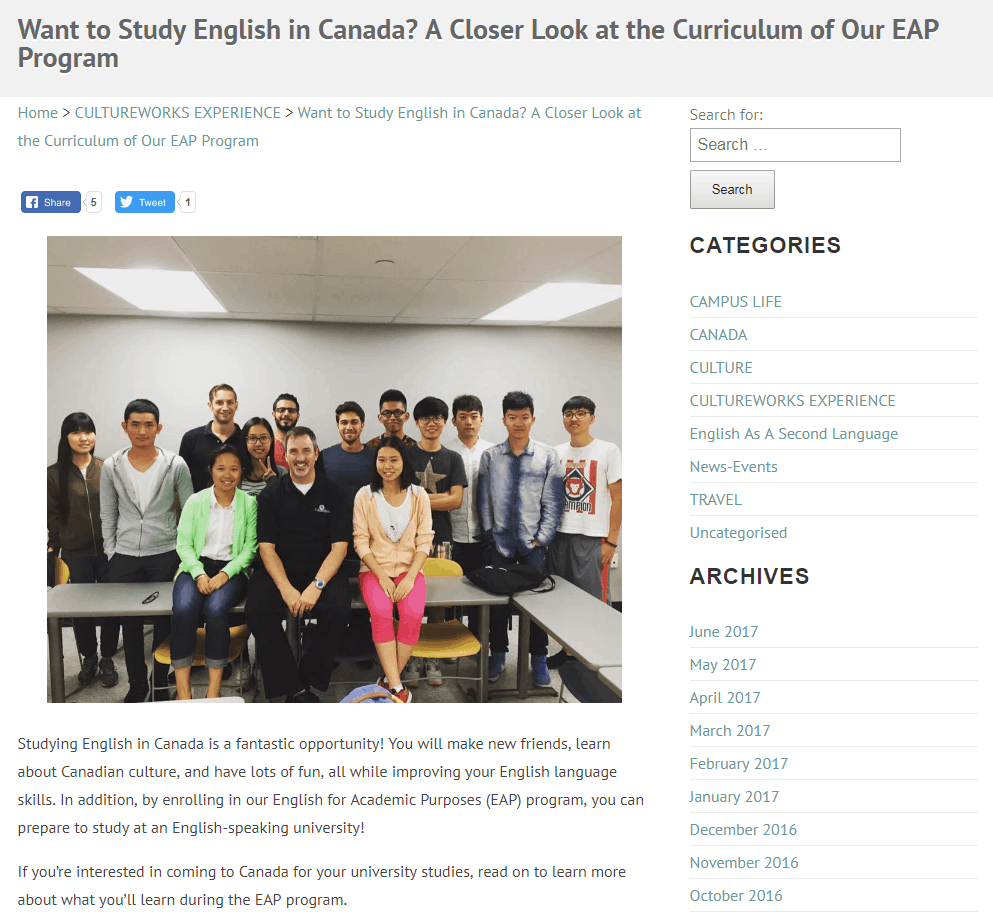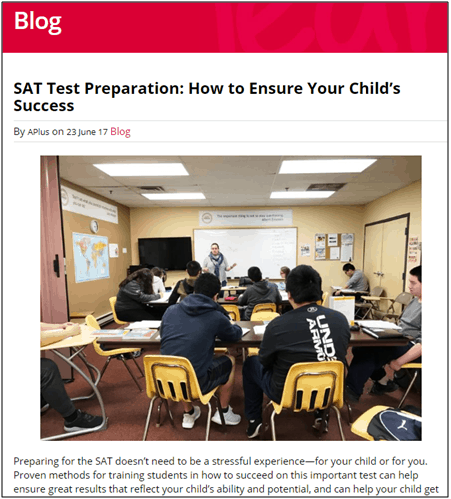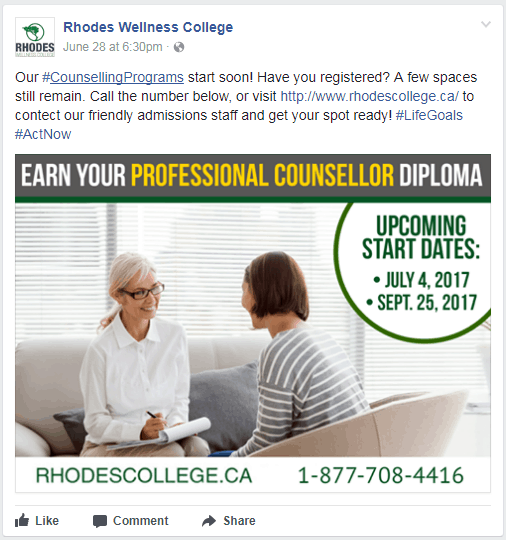
Throughout the year, your school’s marketing needs will shift and change. At some point, you may need to promote a particular program more than others. Whether you need a minimum number of students to enroll to run the program or you’re promoting a brand new offering, your digital marketing efforts may need to be adjusted to your strategic marketing for student recruitment.
By focusing on one program, zeroing in on its key strengths, and developing a program-specific target persona, you can more effectively reach prospective students and move them through the funnel toward conversion and enrolment.
If you want to develop a specific strategy for an individual program, read on to learn more.
Why Should Your School Promote Programs Individually?
Whether a program is one of your school’s largest offerings or a small niche course designed for a specialized career path, there are many reasons why you may want to single it out and focus your efforts on promoting it.
Some examples of when program-specific marketing strategies for student recruitment are particularly useful include if a program is underperforming and you need to boost its enrolment numbers or you’re launching a new course and need to increase awareness. Perhaps you may have added new elements to your curriculum or improved your facilities and want to capitalize on these changes. You may even run seasonal programs, such as summer courses, and need to increase your recruitment efforts at specific times of the year. Whatever your reason, there are several important considerations to remember when creating a strategy for marketing your course.
Target the Right Prospective Students Using Customized Personas
Depending on your needs, you may have an overarching target persona for your entire school or specific personas for different demographics or age groups. However, strategic marketing for student recruitment in particular courses may include formulating new personas designed to target the ideal student of that program. This will help you to tailor your messaging better and appeal directly to the persona’s needs, concerns, and motivations. Some questions to consider when developing program-specific personas include:
- What is a typical student’s age range, location, and socioeconomic background in this program? Does it differ from your primary target audience?
- What concerns may the prospective student have about enrolling in this particular program?
- What is motivating the student to enroll in this program?
- Who are your main competitors for this program? What advantages does your course offer over other schools? (e.g. better facilities, lower costs, etc.)
- What outcomes do typical students in this program expect? Are they hoping to find a job, learn a particular skill, or progress to study further?
While more general student personas are often more concerned with school facilities, amenities, financial aid, and broader information about subject choice, personas for individual programs must look more closely at the prospective student and their interest in the specifics of that particular program.
You also want to ensure that all content promoting the program conveys the right message. By developing key messages in your content highlighting your program’s unique selling points, prospective students can more easily overcome any barriers to applying and move down the funnel. You can draw these key messages directly from the persona you created.
Using Your Website in a Program-Specific Marketing Strategy for Student Recruitment
For some potential recruits, your website’s homepage could be their first point of contact with your school. If you want to increase enrolment in a particular program, featuring it on your homepage is a good way to increase awareness and point prospective students toward the program page.
Example: The International Beauty Institute features its Make-up Artist Diploma Program on its homepage. The content addresses several important points, including internship opportunities and the ability to develop a portfolio, which would appeal to both personas looking to begin a promising career in make-up artistry.

By featuring the program front and center on your website, you will help ensure it doesn’t go unnoticed by prospective students entering your website from the homepage.
You should also pay particular attention to the program page of the specific course you are trying to promote. This may also attract substantial traffic from students searching for particular courses online, and the course needs to be as detailed and enticing as possible. Your persona research may reveal some important points to include here, such as careers that past graduates have been successful in, practicum or internship opportunities included in the program, specific course content, scheduling, and course delivery.
Example: Vancouver Community College’s Bachelor of Hospitality Management program page includes information about the program structure, length, start date, and availability. In addition, links at the bottom of the page open to reveal additional information about the program that a prospective student would be interested in.

Highlighting Programs Using Engaging Blog Posts
Blog posts are another excellent way to promote a specific program. Blogs offer more flexibility in presenting information, whether you want to speak about a program directly or write a blog on a general topic. By mentioning a course more frequently on your blog, you can generate more awareness amongst your online audience.
Example: CultureWorks, an English language school in Canada, promotes its EAP Program in a blog post that outlines its curriculum.

If you want to promote your program more subtly, discussing general topics that the persona would find valuable and interesting is a great way to generate awareness and provide prospective students with useful or interesting information about that field. Integrating carefully selected keywords and links throughout the blog will also help your course rank higher in search engine results.
Example: ASC A+, a school in Boston, USA, that offers enrichment programs for students in grades two to 12 promotes its SAT prep course by publishing a blog about how parents can help their child prepare for the exam. While the post doesn’t promote the program outright, several keywords that relate to the program and link back to the program page are integrated throughout the post.


Strategies for Promoting Specific Programs on Social Media
Social media is another useful channel for promoting individual programs. It allows prospective students to engage with your school directly about the course in fun and interesting ways.
Instagram, for instance, can be particularly effective when finding more visual ways to promote your offerings. Posting photos or videos of current students participating in the program will provide potential recruits with a valuable look at the courses.
Example: Falmouth University promotes its fashion program on Instagram. Students in Fashion & Textiles courses are shown in the classroom working on projects.

If you want to fill remaining spots in a program right up to its start date, you can also use social media to raise awareness, creating posts that include information on application deadlines, availabilities, contact information, and even links to encourage prospective students to seek more information.
Example: Rhodes Wellness College in Vancouver promotes its Professional Counsellor Diploma program by letting students know there’s still time to apply, but only limited spots are available. The post includes links, contact info, start dates, and relevant hashtags.

Don’t be afraid to get creative to get the attention of your audience. Social media “stories” are a fun way to interact with prospective students and answer their questions, and there’s no reason why you can’t tailor your stories to promote one program in particular. In addition, don’t forget to utilize other platforms where your target persona may be found, such as LinkedIn, Twitter, and Pinterest.
Using Email Campaigns to Promote Specific Programs
Email campaigns can also raise awareness of a specific program you want to promote. There are many different types of campaigns, from newsletters and promo emails to extensive lead nurturing campaigns, which can help increase applications.
Newsletters, whether biweekly or monthly, are a great option for getting information about your program on potential recruits’ screens. They can be used to discuss a program directly or distribute other content, like related blog posts.
Lead nurturing campaigns are also an excellent addition to any higher education digital marketing strategy for student recruitment. Nurturing campaigns are designed to deliver highly targeted content at optimal points in the user journey to move a prospect down the funnel.
Using a customer relationship management (CRM) system, you can create smart lists to segment potential leads based on what program they have shown interest in. This allows you to create more tailored, personalized communications that highlight specific aspects of the course while focusing your efforts on those who are most likely to convert. By crafting insightful emails with important information prospective students would want to know at each user journey stage, you can help move them towards enrolment.
It’s important to ensure that each email’s message is crafted for the program-specific persona you developed. This will help ensure the content is not only timely but relevant. In addition, your school must have a process for following up with students who make inquiries. This includes making your student-facing admissions team aware that you’re pushing a particular program so they are prepared to answer any students’ questions.
Using Paid Advertising to Promote a Program is an Effective Marketing Strategy for Student Recruitment
Investing in paid advertising is an ideal route if you’re looking to garner qualified leads quickly. While organic practices like blogging, SEO, and social media are effective, paid advertising is optimal if you need results in a short period.
Employing a program-specific pay-per-click (PPC) campaign on search engines like Google or Bing will help ensure that your course appears near the top of search results when prospective students search for related terms.
In addition, don’t forget the importance of creating a landing page for your PPC campaign. A well-designed landing page should provide enough information to entice users to provide their contact details, converting them into formal leads. Then, you can follow up with them to move them down the funnel.
Example: CDI College advertises its Dental Assistant Training Program on Google.

When the ad is clicked, the prospective student is taken to a landing page with some details about the program, as well as an above-the-fold form that prospective students can complete to receive additional information.

When it comes time to promote a specific program at your school, the tips in this blog will prove quite handy. Above all else, ensuring the content, message, and style are well-suited to a program-specific persona will help you achieve results.
Narrowing in on just one program presents the unique opportunity to be extremely specific and targeted with your messaging. By understanding your persona and getting your messaging right, you can reach out to prospective students. Hence, they feel like what they’re reading was written just for them, which is invaluable when recruiting students.
FAQ To Consider:
How do you recruit students for a program?
Narrowing in on just one program presents the unique opportunity to be extremely specific and targeted with your messaging. By understanding your persona and getting your messaging right, you can reach out to prospective students. Hence, they feel like what they’re reading was written just for them, which is invaluable when recruiting students.






